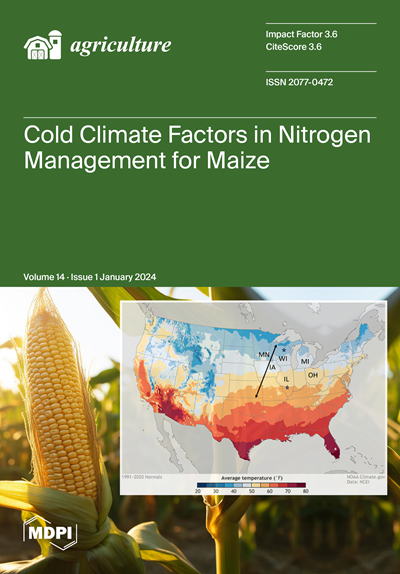3种不同木霉防治小麦幼苗条锈病的研究
IF 3.6
2区 农林科学
Q1 AGRONOMY
引用次数: 1
摘要
小麦条锈病(WSR)是由小麦条锈病引起的。小麦黑穗病是影响世界小麦种植区的主要病害之一。为了控制这种严重的疾病,人们做出了许多努力,包括使用杀菌剂和培育高抗性基因型。然而,由于Pst能够产生新的小种来克服这些杀菌剂并打破高抗性基因型的抗性,因此迫切需要寻找其他有效的方法来限制这种疾病。生物防治是防治作物病害的有效方法之一。本研究对3种不同的木霉(asperellum Trichoderma T34, Trichoderma harzianum (TH), Trichoderma verdinium (TV))在一组34个小麦基因型的苗期进行了效率试验。在两种不同的温度条件下进行了两个实验。每个试验采用对照、T34、TV、TH 4个处理。在每个试验和每个木霉处理下,所有基因型之间存在较高的遗传变异。值得注意的是,除T34外,其他处理的WSR症状均受温度影响,T34在两个实验中表现稳定。研究的34个基因型高度多样化,涉及10个不同的国家,包括硬粒小麦和面包小麦。在3个研究的木霉品种中,T34在所有研究的基因型中都能提高小麦对WSR的抗性,这表明它在不同的小麦遗传背景下都能有效地诱导小麦对WSR的抗性并产生启动反应。本研究结果为木霉防治白斑病的有效性提供了非常有用的信息。本文章由计算机程序翻译,如有差异,请以英文原文为准。
Alleviation of Stripe Rust Disease in Wheat Seedlings Using Three Different Species of Trichoderma spp.
Wheat stripe rust (WSR) caused by Puccinia striiformis F. tritici Erikss. (Pst) is one of the serious diseases that affect wheat planting areas around the world. Many efforts have been made to control such a serious disease including using fungicides and breeding highly resistant genotypes. However, due to Pst’s ability to produce new races that overcome these fungicides and break the resistance in the highly resistant genotypes, looking for other effective ways to restrict this disease is urgently required. One of the highly effective ways of controlling crop diseases is using biological control. In this study, the efficiency of three different Trichoderma species (Trichoderma asperellum T34, Trichoderma harzianum (TH), and Trichoderma verdinium (TV)) was tested in a set of 34 wheat genotypes at the seedling stage. The evaluation was conducted in two experiments with two different temperature regimes. In each experiment, four treatments were applied, namely, control, T34, TV, and TH. High genetic variation was found among all genotypes in each experiment and under each Trichoderma treatment. Notably, the symptoms of WSR were affected by temperature under all treatments except T34, which had a stable performance in the two experiments. The 34 studied genotypes were highly diverse, related to ten different countries, and consisted of durum and bread wheat. Out of the three studied Trichoderma species, T34 was able to improve WSR resistance in all the studied genotypes suggesting its effectiveness in inducing the resistance and producing a priming response in different wheat genetic backgrounds. The results of this study provided very useful information on the effectiveness of Trichoderma spp. in controlling WSR.
求助全文
通过发布文献求助,成功后即可免费获取论文全文。
去求助
来源期刊

Agriculture-Basel
Agricultural and Biological Sciences-Food Science
CiteScore
4.90
自引率
13.90%
发文量
1793
审稿时长
11 weeks
期刊介绍:
Agriculture (ISSN 2077-0472) is an international and cross-disciplinary scholarly and scientific open access journal on the science of cultivating the soil, growing, harvesting crops, and raising livestock. We will aim to look at production, processing, marketing and use of foods, fibers, plants and animals. The journal Agriculturewill publish reviews, regular research papers, communications and short notes, and there is no restriction on the length of the papers. Our aim is to encourage scientists to publish their experimental and theoretical research in as much detail as possible. Full experimental and/or methodical details must be provided for research articles.
 求助内容:
求助内容: 应助结果提醒方式:
应助结果提醒方式:


